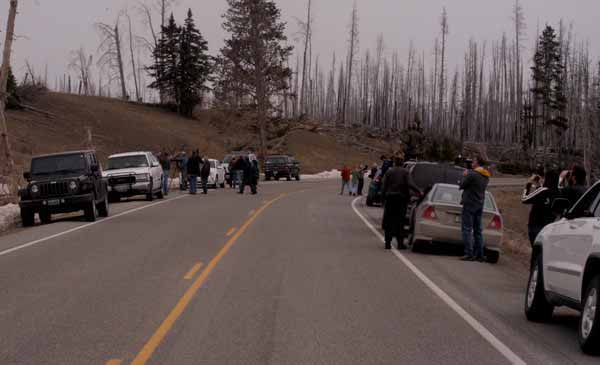
By Ruffin Prevost
CODY, WYO. — David Hanna was diagnosed with cancer in 2010, and spent much of the next two years in treatment and recovery. When he was declared cancer-free last year, he began planning a dream vacation to Yellowstone National Park. His goal was to get into the park as soon as possible.
On Friday, the first day Yellowstone was open to Cody, Wyo. through the East Entrance, David stood at Steamboat Point above Yellowstone Lake, shooting snapshots of his wife, Verna.
“It’s just amazing. I’ve never seen anything like this,” David said as he looked out over the frozen lake and the steaming fumarole nearby.
The Hannas, chicken farmers from Magee, Miss., had left home in mid-April, towing a travel trailer and stopping along the way to take in sights like Mount Rushmore. By the time they reached Cody, they were low on supplies and ready to restock.
“We’re down to potted meat and crackers,” David joked.
The Hannas said they were worried that David’s dream vacation might be delayed when they heard news that federal budget cuts under the Congressional sequester would mean a late opening for Yellowstone.
They were delighted to hear that the Wyoming communities of Cody and Jackson were raising private funds to pay for state personnel and equipment to help get the roads plowed on time, allowing them to keep their original schedule.
“We were calling the whole time we were on the road to make sure it would still be open on time,” Verna said.
David and Verna ended up reaching Cody a few days before Friday’s season opening for the park, so they took in the local sights, coming away “real impressed with Wyoming and amazed with everything Cody has to offer,” David said.
The Hannas’ experience is exactly what business leaders in Cody and Jackson have said they were aiming for when they decided to help fund snow plowing, an effort backers say has paid dividends in positive national headlines and widespread goodwill among early visitors.
But for many others visiting Yellowstone on Friday, the politics and economics of snow plowing took a back seat to the animals, including a grizzly sow and her cub spotted between Sedge Bay and Lake Butte Overlook.
A group of photographers and wildlife watchers lined the road Friday afternoon as the bear, dubbed “Blaze” by park regulars familiar with the mother grizzly, moved in and out of view. If Blaze was concerned about the sudden seasonal reappearance of homo sapiens along the East Entrance road, she didn’t seem to show it.
Elsewhere in the park, another group spent part of the day straining to see a grizzly bear and a white wolf, both moving through the Hayden Valley.
“We’ve had some incredibly good luck spotting things whenever we come early,” said Gayle Six, who drove up from Salt Lake City, Utah for an early visit to the park.
Six was among a large group of wildlife watchers tracking a white wolf that was walking along the Yellowstone River.
She usually visits Yellowstone a couple of times each year, Six said, typically at least once in May or June, “before it gets way too busy.”
Many in the park Friday said they liked visiting Yellowstone before July or August, when crowds make it more difficult to move around or take in the sights.
The trade-off is cooler weather—it was 32 degrees atop Sylvan Pass at mid-morning—and fewer facilities and services available.
For the Hannas, fewer people and more visible animals was just fine. Although the chicken farmers said they were a bit perplexed to see bison wandering around Yellowstone while also showing up on local restaurant menus in Cody.
“Who would want to eat one of those?” David asked. “They should be eating more chicken.”
Contact Ruffin Prevost at 307-213-9818 or [email protected].
